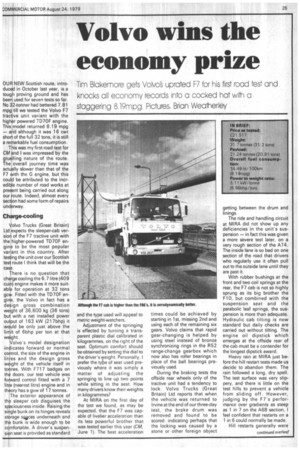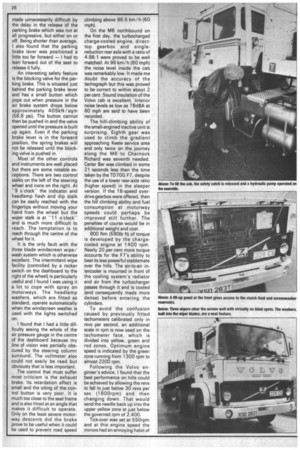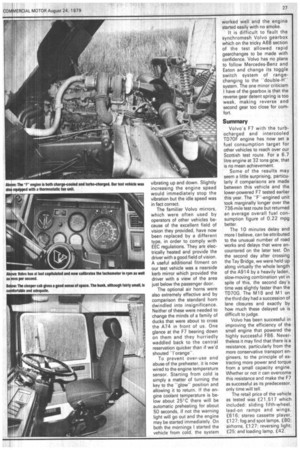Volvo wins the economy prize
Page 27

Page 28

Page 29

If you've noticed an error in this article please click here to report it so we can fix it.
Tim Blakemore gets Volyo uprated F7 for his first road test and knocks ail economy records into a cocked hat wh a staggering 8,19mpg. Pictures, Brian Wea erley
OUR NEW Scottish route, introduced in October last year, is a tough proving ground and has been used for seven tests so far. No 32-tonner had bettered 7.81 mpg till we tested the Volvo F7 tractive unit variant with the higher powered TD7OF engine. This model returned 8.19 mpg — aid although it was 16 cwt short of the full 32 tons, it is still a remarkable fuel consumption.
T is was my first road test for CM and I was impressed by the gruelling nature of the route. The overall journey time was actually slower than that of the F7 ith the G engine, but this coul • be attributed to the incredi le number of road works at pre eat being carried out along Our oute. indeed, almost every SOO on had some form of repairs Lind rway.
Ch rge-cooling
olvo Trucks (Great Britain) Ltd expects the sleeper-cab versio of the F7 tractive unit with the higher-powered TD7OF engin to be the most popular var ant in this country. After tes ing the unit over our Scottish tes route I think that will be the cas .
here is no question that ch rge cooling the 6.7 litre (409 cui ) engine makes it more suitabl for operation at 32 tons gc . Fitted with the TD7OF engine, the Volvo in fact has a de ign gross combination we ght of 36,600 kg (36 tons) bu with a net installed power ou put of 163 kW (217bhp) it w uld be only just above the Ii it of 6bhp per ton at that w ight.
olvo's model designation in icates forward or normal co trol, the size of the engine in lit es and the design gross w ight of the vehicle itself in to nes. With F717 badges on th doors, our test vehicle was to ard control fitted with a 7 lit e (nearest litre) engine and in th ory has a gvw of 17 tonnes.
The exterior appearance of th sleeper cab disguises the s ciousness inside. Raising the
si gle bunk on its hinges reveals st rage stQces underneath and
th bunk is wide enough to be c mfortable. A driver's suspensi n seat is provided as standard and the type used will appeal to metric weight-watchers.
Adjustment of the springing is effected by turning a transparent plastic dial calibrated in kilogrammes, on the right of the seat. Optimum comfort should be obtained by setting the dial to the driver's weight. Personally. I prefer the tyile of seat used previously where it was simply a matter of adjusting the springing to line up two points while sitting in the seat. How many drivers know their weights in kilogrammes?
At MIRA on the first day of the test we found, as may be expected, that the F7 was capable of livelier acceleration than its less powerful brother that was tested earlier this year (CM. June 1). The best acceleration
times could be achieved by starting in 1st, missing 2nd and using each of the remaining six gears. Volvo claims that rapid gear-changing is helped by using steel instead of bronze synchronizing rings in the R52 range-change gearbox which now also has roller bearings in place of the ball bearings previously used.
During the braking tests the offside rear wheels only of the tractive unit had a tendency to lock. Volvo Trucks (Great Britain) Ltd reports that when the vehicle was returned to Irvine at the end of our three-day test, the brake drum was removed and found to be scored. indicating perhaps that the locking was caused by a stone or other foreign object
getting between the drum and linings.
The ride and handling circuit at MIRA did not show up any deficiencies in the unit's suspension — in fact this was given a more severe test later, on a very rough section of the A74. The inside lane is so bad on one section of the road that drivers who regularly use it often pull out to the outside lane until they are past it.
With rubber bushings at the front and two coil springs at the rear, the F7 cab is not so highly sprung as its big brother the F10, but combined with the suspension seat and the parabolic leaf springs, the suspension is more than adequate. Hydraulic cab tilting is now standard but daily checks are carried out without tilting. The engine oil dipstick which emerges at the offside rear of the cab must be a contender for the longest dipstick award.
Heavy rain at MIRA just before the hill restart tests made us decide to abandon them. The rain followed a long, dry spell. The test surface was very slippery, and there is little on the test hills to prevent a vehicle from sliding off. However, judging by the F7's performance over gradients as steep as 1 in 7 on the A68 section, I feel confident that restarts on a 1 in 6 could normally be made.
Hill restarts generally were made unnecessarily difficult by the delay in the release of the parking brake which was not at all progressive, but either on or off. Being shorter than average, I also found that the parking brake lever was positioned a little too far forward — I had to lean forward out of the seat to release it fully.
An interesting safety feature is the blocking valve for the parking brake. This is situated just behind the parking brake lever and has a small button which pops out when pressure in the air brake system drops below approximately 405kN /sqm (58.8 psi). The button cannot then be pushed in and the valve opened until the pressure is built up again. Even if the parking brake lever is in the forward position, the spring brakes will not be released until the blocking valve is pushed in.
Most of the other controls and instruments are well placed but there are some notable exceptions. There are two control stalks on the left of the steering wheel and none on the right. At "9 o'clock' the indicator and headlamp flash and dip stalk can be easily reached with the fingertips without moving your hand from the wheel but the wiper stalk is at "'11 o'clock" and is much more difficult to reach. The temptation is to reach through the centre of the wheel for it.
It is the only fault with the three blade windscreen wipe / wash system which is otherwise excellent. The intermittent wipe facility (controlled by a rocker switch on the dashboard to the right of the wheel) is particularly useful and I found I was using it a lot to cope with spray on motorways. The headlamp washers, which are fitted as standard, operate automatically when the windscreen washer is used with the lights switched on.
I found that I had a little difficulty seeing the whole of the air pressure gauge in the centre of the dashboard because my line of vision was partially obscured by the steering column surround. The voltmeter also could not easily be read but obviously that is less important.
The control that must suffer most criticism is the exhaust brake. Its retardation effect is small and the siting of the control button is very poor. It is much too close to the seat frame and is also fitted at an angle that makes it difficult to operate. Only on the least severe motorway descents did the brake prove to be useful when it could be used to prevent road speed climbing above 96.5 km/h (60 mph).
On the M6 northbound on the first day, the turbocharged charge-cooled engine, directtop gearbox and singlereduction rear axle with a ratio of 4.86:1 were proved to be well matched. At 96 km/h (60 mph) the noise level inside the cab was remarkably low. It made me doubt the accuracy of the tachograph but this was proved to be correct to within about 2 per cent. Sound insulation of the Volvo cab is excellent. Interior noise levels as low as 78dBA at 60 mph are said to have been recorded.
The hill-climbing ability of the small-engined tractive unit is surprising. Eighth gear was used to climb the gradient approaching Keele service area and only twice on the journey along the M6 to Charnock Richard was seventh needed.
Carter Bar was climbed in some 21 seconds less than the time taken by the TD7OG F7, despite the use of a lower rear-axle ratio (higher speed) in the sleeper version. If the 16-speed over drive gearbox were offered, then the hill climbing ability and fuel consumption at motorway speeds could perhaps be improved still further. The penalties of course would be in additional weight and cost.
800 Nm (590lb ft) of torque is developed by the charge cooled engine at 1400 rpm.
Nearly 20 per cent more torque accounts for the F7's ability to beat its less powerful stablemate over the hills. The air-to-air intercooler is mounted in front of the cooling system's radiator and air from the turbocharger passes through it and is cooled (and consequently made more dense) before entering the cylinders.
To avoid the confusion caused by previously fitted tachometers calibrated only in revs per second, an additional scale in rpm is now used on the tachometer face, which is divided into yellow, green and red zones. Optimum engine speed is indicated by the green zone running from 1300 rpm to almost 2200 rpm.
Following the Volvo engineer's advice, I found that the best performance on hills could be achieved by allowing the revs to fall to just below 30 revs per sec (1800rpm) and then changing down. That would send the needle back up into the upper yellow zone at just below the governed rpm of 2,400.
Tick-over was set at 550rpm and at this engine speed the mirrors had an annoying habit of vibrating up and down. Slightly increasing the engine speed would immediately stop the vibration but the idle speed was in fact correct.
The familiar Volvo mirrors, which were often used by operators of other vehicles because of the excellent field of vision they provided, have now been replaced by a different type, in order to comply with EEC regulations. They are electrically heated and provide the driver with a good field of vision. A useful additional fitment on our test vehicle was a nearside kerb mirror which provided the driver with a view of the area just below the passenger door.
The optional air horns were also extremely effective and by comparison the standard horn dwindled into insignificance. Neither of these were needed to change the minds of a family of ducks that were about to cross the A74 in front of us. One glance at the F7 bearing down on them and they hurriedly waddled back to the central reservation quicker than if we'd shouted "l'orange-.
To prevent over-use and abuse of the preheater, it is now wired to the engine temperature sensor. Starting from cold is simply a matter of turning the key to the "glow" position and allowing it to return. If the engine coolant temperature is below about 25'C there will be automatic preheating for about 50 seconds, if not the warning light will go out and the engine may be started immediately. On both the mornings I started the vehicle from cold, the system worked well and the engine started easily with no smoke.
It is difficult to fault the synchromesh Volvo gearbox which on the tricky A68 section of the test allowed rapid gearchanges to be made with confidence. Volvo has no plans to follow Mercedes-Benz and Eaton and change its toggle switch system of rangechanging to the "double-H" system. The one minor criticism I have of the gearbox is that the reverse gear detent spring is too weak, making reverse and second gear too close for comfort.
Summary
Volvo's F7 with the turbocharged and intercooled TD7OF engine has now set a fuel consumption target for other vehicles to reach over our Scottish test route. For a 6.7 litre engine at 32 tons gcw, that is no mean achievement.
Some of the results may seem a little surprising, particularly if comparisons are made between this vehicle and the lower-powered F7 tested earlier this year. The "F--engined unit took marginally longer over the 736-mile test route but returned an average overall fuel consumption figure of 0.22 mpg better.
The 10 minutes delay and more I believe, can be attributed to the unusual number of road works and delays that were encountered on the later test. On the second day after crossing the Tay Bridge, we were held up along virtually the whole length of the A914 by a heavily laden, slow-moving combination yet in spite of this, the second day's time was slightly faster than the TD70G. The M18 and M1 on the third day had a succession of lane closures and exactly by how much these delayed us is difficult to judge.
Volvo has been successful in improving the efficiency of the small engine that powered the highly successful F86. Nevertheless it may find that there is a resistance, particularly from the more conservative transport engineers, to the principle of extracting more power and torque from a small capacity engine. Whether or not it can overcome this resistance and make the F7 as successful as its predecessor, only time will tell.
The retail price of the vehicle as tested Was £21,517 which included: sliding fifth-wheel, lead-on ramps and wings, £616; stereo cassette player, £127; fog and spot lamps, £80; airhorns, 27: reversing light; £25; and loading lamp, £42.








































































































